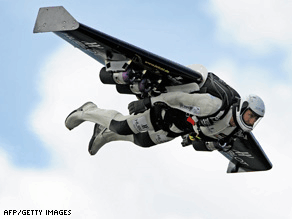
Man Attempts To Cross English Channel With Jet Wing 175
Back in May, we told you about Swiss pilot Yves Rossy and his personal jet powered wing. It seems Mr. Rossy will now try to cross the English Channel with his invention. The flight was planned for Sept. 25 but had to be canceled due to poor weather. Yves will leap from a plane more than 2,500 meters off the ground, fire up his jets and try to make the 35-kilometer flight from Calais in France to Dover in England. If all goes well, the flight will take about 12 minutes. I'd like to officially ask Mr. Rossy for a review model for Slashdot.

Talk about a... (Score:2, Interesting)
I don't think he'll even be high enough above the ground for a parachute if everything doesn't work out!
Re:Talk about a... (Score:5, Interesting)
I don't think he'll even be high enough above the ground for a parachute if everything doesn't work out!
At 5100 feet, he'll be covered.... [fabulousrocketeers.com]
fly or glide? (Score:2, Interesting)
Why so high to start with?
He doesn't have fuel to make it across fully on it's own power i suppose.
From 2500 meters one could glide across in a variety of craft it appears. This would seem about twice the glide ratio of a small plane, doesn't sound too hard with a powered wing. Especially as it seems the wing actually does fly ok, it must be a range issue.
Heck if you let me start high enough i could fly my car across. Ok i might need oxygen and better shocks but still....
Looks like fun nonetheless, at least until i have to land with 120 lbs on my back then i'd just be a squished little geek :(
Re:Could you explain that... (Score:4, Interesting)
Re:Information about the jets (Score:2, Interesting)
From the manual:
Safety Precautions
If other persons or animals are present while operating the JetCat ENGINE, ALWAYS ENFORCE THE PROPER MINIMUM SAFE DISTANCES FROM THE TURBINE!
The recommended minimum safe distances are:
In front of the turbine = 15 feet
On the side of the turbine = 25 feet
Behind the turbine = 15 feet
In case of a mishap, fire extinguishers should be on hand at all times. JETCAT USA recommends the CO/2 variety. Powdered extinguishers will contaminate the precision components, upsetting the integrity of the turbine.
To the avoid hearing damage, always use hearing protection when you are near a running turbine engine!
When the turbine is running, never place your hands closer than six inches into the area of the intake. An extreme suction - which can grasp a hand, fingers or other objects in a flash - prevails in this area. Be aware of this source of danger, always!
Prevent foreign materials from entering the intake or exhaust when working with the turbine. Before operation, make sure there are no lose parts or debris near the turbine. Objects being sucked in can cause severe damage.
Always exercise caution around the hot parts of the turbine, to avoid burns. The outer case at the turbine stage and nozzle reaches 450-500Â (Celsius), while the exhaust gas may exceed 720 ÂC.
Assure that the fuel is mixed with approximately 5% synthetic oil. Use only synthetic turbine oils available at local airport fuel suppliers or from JETCAT USA. Synthetic turbine oils are dangerous and should only be handled per the manufactures MDS sheets
Never run the turbine in a closed room, or an area near any kind of flammable matter. Do not fly turbine-powered aircraft near flammable materials, nor in forested tracts or areas experiencing drought or dryness. Obey all forest fire regulations and warnings by refraining from operating the JetCat ENGINE in restricted fire zones. Never operate model turbine jet aircraft in or around residential or heavily populated areas.
Installation of unauthorized parts from another manufacturing source may also result in engine failure. Do not introduce engine or electronic components other than those delivered by JETCAT USA, unless you are willing to risk destroying your turbine! JETCAT USAâ(TM)s parts are designed and engineered specifically for the JetCat P80/ P120/P160. Accept no substitutes, unless you are prepared to sacrifice your aircraft.
Warning:
A flying model with a turbine can reach higher flight speeds than ducted fan-powered models, because the turbineâ(TM)s thrust degrades less with higher flight speeds. With attainable flight speeds of over 250 MPH, you can quickly run out if flying room. There is also a danger of developing control surface flutter or mechanical overload, causing the model to fail in flight. When piloting a turbine powered aircraft, one must properly control the throttle. Full power should be used for takeoff or vertical maneuvers and a reduced setting for level or descending flight. To restrict the maximum flight speed, an optional airspeed sensor is available.
Re:fly or glide? (Score:1, Interesting)
A few notes on his powerplant setup.
*Jet turbines are more efficient the higher you are, up to about 36000' and change, where the air is coldest. I know the air is also less dense, but that's also is less drag for the flying body, and the engine does a lot of it's own compression. (the temp actually levels out above that, and rises again up higher)
*His earlier model had enough go-juice for about 5 minutes, and this one isn't much bigger. I'm sure squeezing out any little bit for efficiency is important here.
*Even tiny turbines can have a bad day and be temperamental to start, so I, too, would like a little fall/glide distance to determine everything came online properly.
*Also I'll second the no-gear, can't-run-enough, need speed thing posted before me. It's also possible those jets require a bit of ram-air to get going without stalling. (on-the-ground modelers have used leaf-blowers for that)
This CowAnon works for a company currently trying to solve an engine stall problem on a 4500HP turbine powerplant, and that's when it's already running.
Re:Talk about a... (Score:2, Interesting)